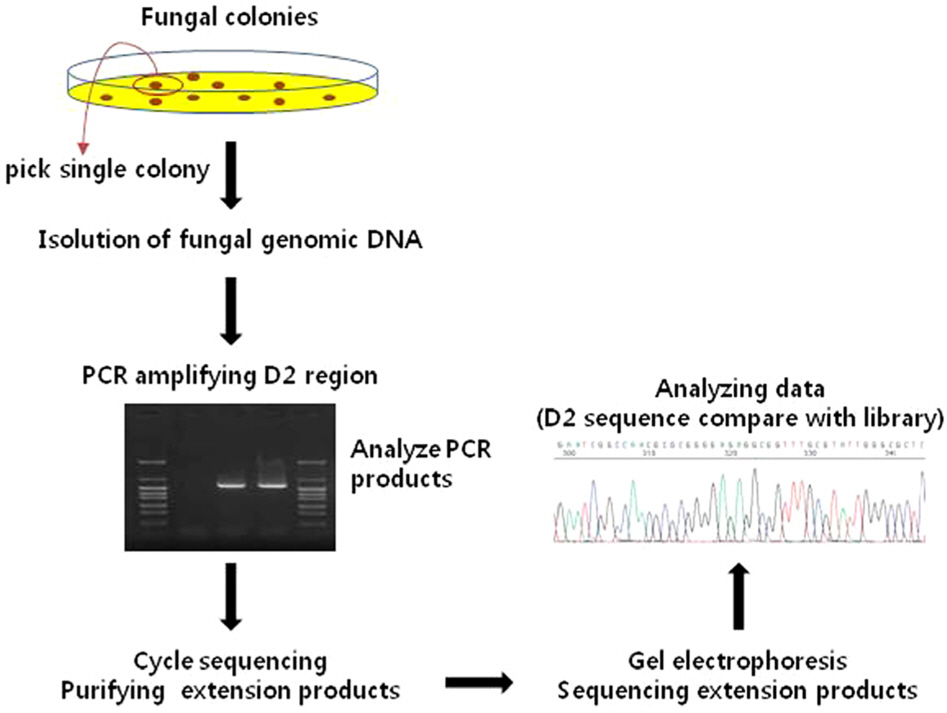J Korean Ophthalmol Soc.
2014 Jun;55(6):923-927.
A Case of Beauveria Bassiana Keratitis Confirmed by Gene Sequencing
- Affiliations
-
- 1Department of Ophthalmology, Keimyung University School of Medicine, Daegu, Korea. changsd@dsmc.or.kr
- 2Department of Laboratory Medicine, Keimyung University School of Medicine, Daegu, Korea.
- 3Department of Laboratory Medicine, Seoul National University College of Medicine, Seoul, Korea.
Abstract
- PURPOSE
To report a case of Beauveria bassiana keratitis that was confirmed by gene sequencing.
CASE SUMMARY
A 70-year-old man presented to our hospital with complaints of ocular pain and deterioration of the visual acuity in his left eye after injury caused by a wood branch one week previously. Visual acuity in the left eye was 20/400 at the time of the first visit. Slit lamp examination showed a central 0.7 x 2.5-mm-sized epithelial defect surrounded by cellular infiltration in the stroma. Scraping of the corneal lesion for microbiological examinations was performed. Initial Gram stain, potassium hydroxide (KOH) mount, and culture were negative. However, fungal hyphae were observed on a KOH mount of the repeated corneal scraping specimen, and a Beauveria species was suspected based on the culture. Beauveria bassiana was confirmed using a MicroSEQ(R) D2 large-subunit ribosomal DNA fungal sequencing kit. Natamycin eye solution was initially instilled bihourly (every two hours), but the persistent epithelial defect and progressive stromal melting finally resulted in a descemetocele. Temporary and permanent amniotic membrane transplantations were performed, and amphotericin B eye solution was administered bihourly (every two hours). The ulcerous lesion gradually improved with no evidence of recurrence.
CONCLUSIONS
Recently, cases of fungal keratitis have been increasing. Therefore, molecular diagnosis methods such as gene sequencing can be helpful in diagnosis and in improving the prognosis of fungal keratitis caused by rare fungi, as we found in this case.
Keyword
MeSH Terms
Figure
Reference
-
References
1. Wang Q, Xu L. Beauvericin, a bioactive compound produced by fungi: a short review. Molecules. 2012; 17:2367–77.
Article2. Wagner BL, Lewis LC. Colonization of corn, Zea mays, by the en-tomopathogenic fungus Beauveria bassiana. Appl Environ Microbiol. 2000; 66:3468–73.3. Ishibashi Y, Matsumoto Y, Takei K. The effects of intravenous mi-conazole on fungal keratitis. Am J Ophthalmol. 1984; 98:433–7.
Article4. Sachs SW, Baum J, Mies C. Beauveria bassiana keratitis. Br J Ophthalmol. 1985; 69:548–50.5. Low CD, Badenoch PR, Coster DJ. Beauveria bassiana keratitis cured by deep lamellar dissection. Cornea. 1997; 16:698–9.
Article6. Kisla TA, Cu-Unjieng A, Sigler L, Sugar J. Medical management of Beauveria bassiana keratitis. Cornea. 2000; 19:405–6.
Article7. Tu EY, Park AJ. Recalcitrant Beauveria bassiana keratitis: confocal microscopy findings and treatment with posaconazole (Noxafil). Cornea. 2007; 26:1008–10.8. Pariseau B, Nehls S, Ogawa GS, et al. Beauveria keratitis and bio-pesticides: case histories and a random amplification of poly-morphic DNA comparison. Cornea. 2010; 29:152–8.
Article9. Figueira L, Pinheiro D, Moreira R, et al. Beauveria bassiana kerati-tis in bullous keratopathy: antifungal sensitivity testing and mana-gement. Eur J Ophthalmol. 2012; 22:814–8.
Article10. Oh JY, Lee MJ, Wee WR, Heo JW. A case of necrotizing scleroker-atitis and endophthalmitis caused by Beauveria bassiana. Jpn J Ophthalmol. 2009; 53:551–3.
Article11. Jun KR, Jang MS, Park SJ, et al. A case of Beauveria bassiana keratitis. Korean J Clin Microbiol. 2007; 10:73–6.12. Hall L, Wohlfiel S, Roberts GD. Experience with the MicroSeq D2 large-subunit ribosomal DNA sequencing kit for identification of filamentous fungi encountered in the clinical laboratory. J Clin Microbiol. 2004; 42:622–6.
Article13. Thomas PA, Kaliamurthy J. Mycotic keratitis: epidemiology, diag-nosis and management. Clin Microbiol Infect. 2013; 19:210–20.
Article14. Ferrer C, Alió JL. Evaluation of molecular diagnosis in fungal keratitis. Ten years of experience. J Ophthalmic Inflamm Infect. 2011; 1:15–22.
Article15. Kim SJ, Lee SB. Analysis on elderly inpatients with infectious ker-atitis: causative organisms, clinical aspects, and risk factors. J Korean Ophthalmol Soc. 2010; 51:1554–67.
Article16. Valencia JW, Gaitán Bustamante AL, Jiménez AV, Grossi-de-Sá MF. Cytotoxic activity of fungal metabolites from the pathogenic fungus Beauveria bassiana: an intraspecific evaluation of beauver-icin production. Curr Microbiol. 2011; 63:306–12.
Article17. Guarro J, Gené J. Acrophialophora fusispora misidentified as Scedosporium prolificans. J Clin Microbiol. 2002; 40:3544. author reply 3545.18. Thomas PA. Current perspectives on ophthalmic mycoses. Clin Microbiol Rev. 2003; 16:730–97.
Article
- Full Text Links
- Actions
-
Cited
- CITED
-
- Close
- Share
- Similar articles
-
- A Case of Beauveria bassiana Keratitis
- Cordyceps bassiana and Production of Stromata in vitro Showing Beauveria Anamorph in Korea
- Successful Development of Cordyceps bassiana Stromata from Beauveria bassiana
- Optimization of Solid-State Fermentation for Improved Conidia Production of Beauveria bassiana as a Mycoinsecticide
- Evaluation of Strains of Metarhizium anisopliae and Beauveria bassiana against Spodoptera litura on the Basis of Their Virulence, Germination Rate, Conidia Production, Radial Growth and Enzyme Activity





